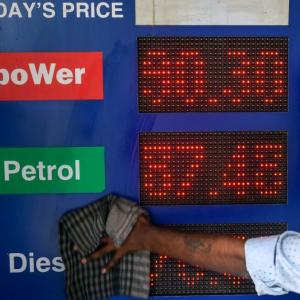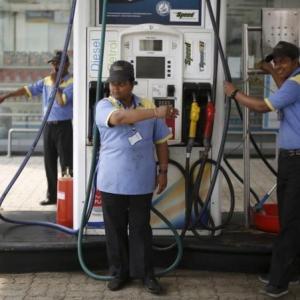 Senior policymakers say it is a tough task and the finance ministry may resort to the time-tested method of carrying forward part of the subsidy payment burden to the next fiscal year.
Senior policymakers say it is a tough task and the finance ministry may resort to the time-tested method of carrying forward part of the subsidy payment burden to the next fiscal year.
The government’s oil subsidy burden has already exceeded Rs 460 billion -- almost 84 per cent higher than the budgeted estimate of Rs 250 billion for the whole financial year, Business Standard has learnt.
“By the end of September, the subsidy burden on cooking gas increased to over Rs 390 billion and that of kerosene to Rs 70 billion,” said a senior official. In FY18, the subsidy for cooking gas was Rs 208.8 billion and that for kerosene was Rs 46.72 billion.
The government has recently cut Rs 1.5 per litre on excise duty of petrol and diesel, which will lead it to loss of Rs 10.5 billion in revenues for October-March. The government will bear around Rs 61 billion of that hit, with states bearing the rest, since 42 per cent of the proceeds from duties are passed on to them.
The big subsidy bill will add to the government’s fiscal deficit woes.
Of the revenue and expenditure data available, while the direct tax data is encouraging, other indicators show that the government could face a shortfall of more than Rs 1 trillion in its share of goods and service tax, and could see additional expenditures of Rs 465 billion, if one includes the latest oil subsidy figures.
So, nearly Rs 1.5 trillion will have to be made up through higher-than-budgeted direct tax proceeds, non-tax revenue and disinvestment, and cut in non-essential spending, if the government is to meet its fiscal deficit target.
Senior policymakers say it is a tough task and the finance ministry may resort to the time-tested method of carrying forward part of the subsidy payment burden to the next fiscal year.
The fiscal deficit target for the year is Rs 6.24 trillion, or 3.3 per cent of the gross domestic product. The fiscal deficit has already hit 94.7 per cent of the target in the first five months.
In absolute terms, it stood at Rs 5.91 trillion. So, in the next seven months, the government will have to contain its excess expenditure over revenues within Rs 330 billion to contain the deficit at the targeted level in absolute terms.
The government’s internal estimates show that it expects an additional outlay of Rs 200 billion just for the newly-announced minimum support price obligations for cereals and pulses. This will be over and above the budgeted food subsidy estimate of Rs 1.69 trillion. It will also provide Rs 20 billion extra for Air India, over and above Rs 163 billion it announced in last Budget.
Also, as reported earlier, the outlay for Ayushman Bharat could increase by Rs 35 billion. Total expenditure for April-August this year stands at Rs 10.7 trillion -- compared with Rs 9.5 trillion for the same period last year -- even before most of the additional spending burden is realised. The total budget size this year, before accounting for additional commitments, was Rs 24.4 trillion.
On Friday, international benchmark Brent crude prices rose to $80.84 a barrel.
Apart from the excise duty cuts, oil marketing companies are absorbing Rs 1 per litre each on petrol and diesel. A number of states have also cut fuel prices by Rs 2.50 per litre. The cut by the OMCs may lead to an annual loss of Rs 45 billion.
According to a Moody’s Investors Service report, the market capitalisation of three OMCs alone has declined by about Rs 2.04 trillion ($27.5 billion) between September 1, 2017, and October 10, 2018. The report added that ONGC will suffer the greatest decline in the market value.
‘The value of its investments declined by about Rs106 billion ($1.4 billion) in the last week. ONGC’s stake in HPCL, which it bought for Rs 369 billion in January 2018, is now worth just about Rs 141 billion, implying a decline in value of Rs 228 billion. ONGC’s stake in IOC, which it valued at Rs 236 billion as of March 2018, is now worth Rs 166 billion, implying a decline of Rs 70 billion,’ the report said.
On Friday, there was a review meeting by the prime minister and petroleum minister Dharmendra Pradhan, on the strategy to improve domestic production. It was attended by officials from ONGC and Oil India. India is planning to increase its domestic production enough by 2022 to be able to curb crude oil import by 10 per cent.
Photograph: Mukesh Gupta/Reuters.









